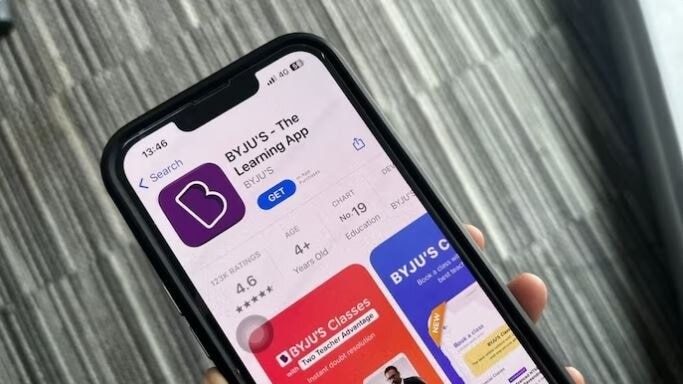Updated on August 1st, 2023 by Eli Inkrot
The end goal of many dividend growth investors is to generate enough passive income to cover their living expenses.
There are two basic solutions to reach this goal:
- Increase the size of your investment portfolio.
- Generate more yield from your existing portfolio.
In general, the only changes that you can make today are to generate more yield. High dividend stocks are useful for this.
You can download a free copy of our full list of high dividend stocks by clicking on the link below:
High dividend stocks can certainly generate more income, but so can dividend-focused option strategies.
In this article, we will introduce the cash secured put income generation strategy, which is one option strategy that you can use to boost the passive income generated by your investment portfolio.
Table of Contents
Video: How To Boost Your Dividend Income Using Cash Secured Puts
For investors who prefer to learn about new strategies through videos, we have created the following video companion to this guide on the cash secured put income generation strategy:
What Is The Cash Secured Put Income Generation Strategy?
To understand what a cash secured put option strategy is, you need to have a fundamental understanding of stock options. Here’s a formal definition of a stock option.
“A stock option is a contract between two parties in which the stock option buyer purchases the right (but not the obligation) to buy/sell 100 shares of an underlying stock at a predetermined price (called the strike price) from/to the option seller within a fixed period of time.”
If the contract allows the option holder to buy the security, it is a call option.
If the contract allows the option holder to sell the security, it is a put option.
Each stock option corresponds to 100 shares of the associated security, which is called the “underlying.” This is a very important concept to understand, and makes the cash secured put strategy unsuitable for investors that have only small amounts of capital to invest.
In a cash secured put option strategy, you sell a put option for a security that you would like to purchase, but at a lower price than it is currently trading. This allows you to receive the option premium upfront in exchange for the obligation (if the option is exercised) to purchase the security at a lower price point.
An image is helpful in understanding the payoff profile of a cash secured put option strategy:
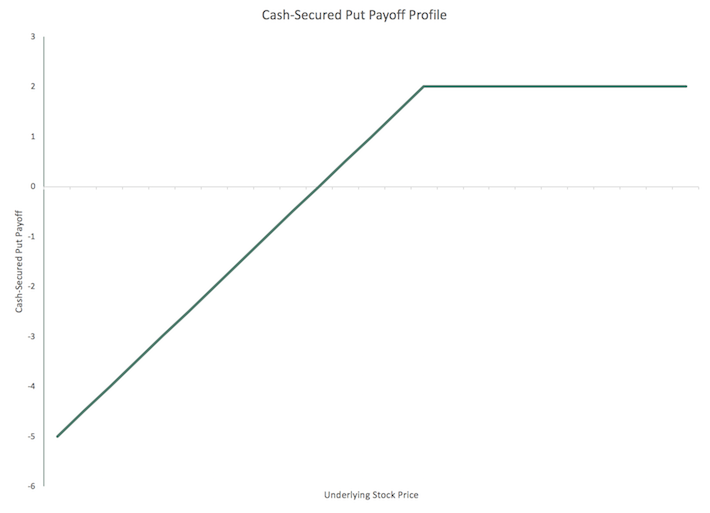
Here, the underlying stock price is on the horizontal axis and the strategy’s payoff profile is on the vertical axis.
As you can see, the upside of the strategy is equal to the option premium received, less any applicable commissions.
As the price of the underlying stock declines past the strike price of the option, the strategy becomes less profitable and, eventually, the investor participating in the cash secured put option strategy loses money. However, keep in mind that the point of this strategy is 1) to generate upfront cash flow and 2) to potentially purchase securities you would be happy to own anyway.
As with any investment strategy, the cash secured put income generation strategy has pros and cons. We will dive into these – beginning with the benefits – before concluding this guide with several examples.
Benefits of The Cash Secured Put Income Generation Strategy
Put Option Benefit #1 = You Get Paid
When you sell cash secured puts, you get paid the option premium upfront. Depending on the security and the price at which you’re willing to buy, this cash flow can be significant. Sometimes the option premiums generated by this strategy can actually dwarf the dividend income generated by the stock itself.
Put Option Benefit #2 = You Can Reinvest Right Away
Cash secured puts allow for immediate reinvestment. Not only can the cash flow be significant, but it also happens immediately. You make an agreement now and a few seconds later that capital is available to you to be deployed. There’s a time value of money aspect here that can make option income more attractive than waiting on other sources of cash flow.
Put Option Benefit #3 = You’re Able To Dictate A Lower Price
When a cash secured put strategy is implemented, there are hundreds of available strike prices and expiration dates. If you would be happy to own a certain stock at $50, then you can structure that agreement and still get paid for doing so. If you would only be happy to own a stock at $45, then you can make that agreement instead, although you will receive a lower option premium in exchange for a lower potential purchase price. Using put options gives you great flexibility in that you’re not simply taking prices that are available on the open market.
Put Option Benefit #4 = Allows You To Own Lower Yielding Securities
You might think that say Visa (V) is an excellent company, but have never really given it much attention due to its low dividend yield. By selling a cash secured put you could get paid for agreeing to buy at a lower price and thus increase your cash flow stream. Options are aptly named. They can open up possibilities that you may not have previously considered.
This concludes our discussion of the benefits to the cash secured put income generation strategy. Next, let’s move on to some potential downsides.
Downsides of the Cash Secured Put Income Generation Strategy
Put Option Downside #1 = You Have To Work In Round Lots
Options trade in “round lots” of 100 shares. Usually share price does not matter (in dollar terms, not in value terms), but in this situation it certainly does because of the round lot requirement. This can limit the feasibility of allocating capital in this manner.
As an example, trading options on Kinder Morgan (KMI) – which has a current stock price of around $18 – is feasible for most investors. Conversely, trading options on Chipotle (CMG) – which has a current stock price over $1,900 – is out of the realm for all but the most affluent.
Put Option Downside #2 = You May Never Own Shares
The cash secured put income generation strategy is not suitable for investors that need to eventually own shares of the underlying company. If the share price stays higher, you may never own shares. Even if the price momentarily moves down past your agreement price this does not mean that it will be automatically triggered.
Incidentally, this is one advantage of a limit order. Although you do not get paid for a limit order, it will transact if shares are trading at or below your set price. With a put option, it’s at the option buyer’s (the seller of the underlying stock) discretion.
Put Option Downside #3 = You Don’t Collect The Dividends While You Wait
With a covered call income generation strategy, you still receive the dividend payments, as you still own the underlying security. With a cash secured put you do not yet own the security and thus you do not collect the dividend payments.
You’re compensated for this with the upfront premium, but it remains that this will be your only cash flow until the option is exercised or it expires.
Put Option Downside #4 = You Might Have To Redeploy The Capital
If you’re a “set it and forget it” type investor, a simple buy and hold strategy is apt to be more attractive to you. With the cash secured put income generation strategy, the option does not have to be exercised. With that said, every time a put option expires without being exercised, you will need to re-initiate the strategy by selling more cash secured puts. This makes the strategy more time-intensive than long-term ownership of the underlying securities.
Put Option Downside #5 = There Are Separate Tax Implications To Think About
If the put option is not exercised, the option premium can be taxed as ordinary (short-term) income.
If the option is exercised, the option premium becomes part of your cost basis and future tax considerations depend on how long you hold the underlying security. There’s an added layer of complexity involved that is not present with buying, holding and collecting qualified dividend payments.
Cash Secured Put Example #1: Johnson & Johnson (JNJ)
The first cash secured put option strategy that we’ll explore is Johnson & Johnson (JNJ), a well-known healthcare conglomerate.
When you look up stock options, you will usually be presented with what is called an “option chain.” An option chain shows the different strike prices for call and put options at a certain expiration date. For example, here is the option chain for Johnson & Johnson that expires on January 19th, 2024:
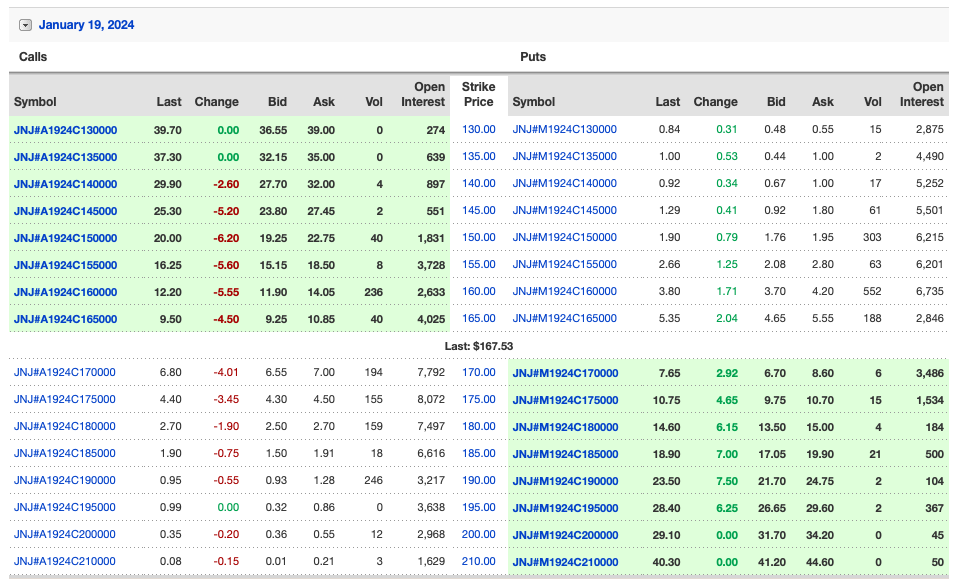
Shares of Johnson & Johnson are presently trading around $168 at the time of this writing. If you want to own shares at this price, you can simply buy in the open market. However, if you would prefer to wait for a lower price you can either 1) set a limit order or 2) sell a cash secured put and get paid upfront for making this willingness to buy at a lower price known. For illustration, let’s suppose that you are interested in agreeing to buy at $160.
The next step is determining how much cash is required to secure the transaction. This is calculated by multiplying the strike price by the number of shares that are associated with the option, which is 100. In this case, an investor needs to $16,000 ($160*100) in their brokerage account to “cash secure” the option in case it is exercised and 100 shares are “put” to you.
There are two nuances that make trading options different than trading common stocks. The first is the relative illiquidity of stock options. As you can see by examining Johnson & Johnson’s option chain, the volume of transactions is low, creating a large bid-ask spread for each strike price in the option chain. As an option seller (which is what we’re doing in a cash secured put strategy), you should budget to receive the “bid” price.
The second unique aspect to pricing options is that even though options contracts correspond to 100 shares of stock, the quoted price is per share. Accordingly, multiply the quoted price by 100 to calculate your actual proceeds from selling 1 cash secured put.
In Johnson & Johnson’s case, this corresponds to $370 per option contract, or $3.70 per share for the $160 strike price expiring January 19th, 2024.
Last, we want to calculate the yield on the collateral we’ve put up against these cash secured puts.
We can calculate the income from the cash secured put strategy using the following formula:

The formula has two factors. The first is option premium divided by the trade’s cash collateral. This factor gives you how much absolute return you received expressed as a percentage of strike price.
The second is 365 divided by days until expiration, which turns your absolute return into an annualized return figure. This is important because almost all rates of return in finance are expressed on an annualized basis, so this improves the comparability of the cash secured put option strategy.
In the case of Johnson & Johnson, here’s what the actual math works out to:
Cash-Secured Put Yield = ($370/$16,000)*(365/171) = 4.9%
The investor received $370 of option premium in exchange for posting collateral of $16,000. The option had 171 days until expiration. This provides an annualized return of 4.9%.
The next two examples will cover other well-known stocks – Coca-Cola (KO) and Berkshire Hathaway (BRK.B) – while sparing some of the detail of this first example.
Cash Secured Put Example #2: The Coca-Cola Company (KO)
You can see Coca-Cola’s options chain here:
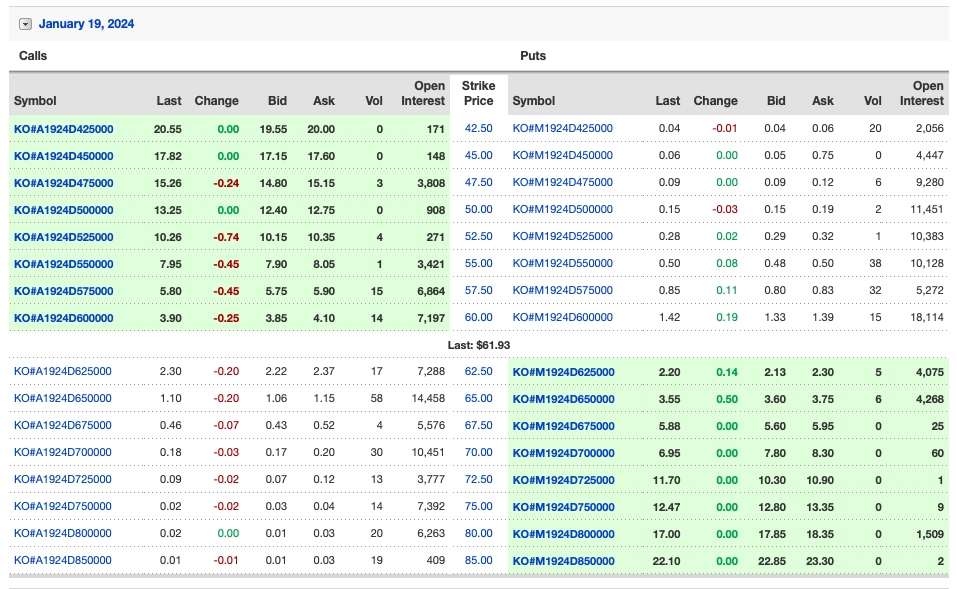
Shares of Coca-Cola are currently trading just under $62. If you were instead interested in buying at say $57.50, you could sell a cash secured put at this price and receive $0.80 per share or $80 per option contract.
Here’s how we would calculate the additional yield that we can generate from cash waiting to buy Coca-Cola by selling these cash secured puts:
Cash-Secured Put Yield = ($80/$5,750)*(365/171) = 3.0%
The $57.50 option dated January 19th, 2024 is selling for $80 per contract. $5,750 of collateral would need to be posted to secure this agreement. This cash secured put provides an annualized yield of 3.0%.
Cash Secured Put Example #3: Berkshire Hathaway (BRK.B)
The next example of a cash secured put strategy that we’re going to explore is for Berkshire Hathaway’s class B shares.
This example is unique because Berkshire Hathaway is the first company in this article that does not pay a dividend. Because of this, Berkshire Hathaway is a great example of how you can generate passive income from companies that do not currently pay dividends.
Here is Berkshire Hathaway’s January 19th, 2024 option chain:
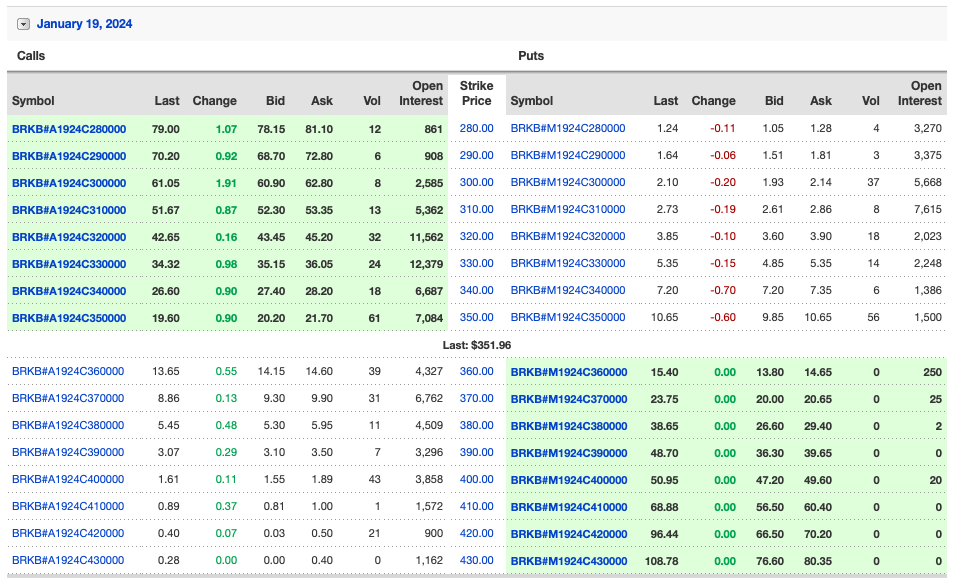
Shares of Berkshire Hathaway are presently trading at $352. Suppose you are willing to buy at $340. At this strike price, the premium is $7.20 or $720 per contract.
Here’s how we can calculate the yield available for this option:
Cash-Secured Put Yield = ($720/$34,000)*(365/171) = 4.5%
The $340 option dated January 19th, 2024 is selling for $720 per contract. $34,000 of collateral would need to be posted to secure this agreement. This cash secured put provides an annualized yield of 4.5%.
Final Thoughts
Selling a cash secured put, in its simplest form, is getting paid to agree to buy at a price that you would be happy with. You might use this strategy to enhance your cash flow or to own a security at a cost that you deem is fair. If you’re going to work with options, you want to make sure that you’d be content with either side of the agreement.
Related: Selling Weekly or Monthly Put Options for Income in 11 Easy Ways
You might be turned off from selling put options due to the added complexity, extra legwork or apprehension about never owning a security. If you’re going to be kicking yourself if shares rise higher, this is something that you should think about before initiating a cash secured put income generation strategy. The psychological barriers are every bit as real as the structural ones. The point is to figure out what may be right for you.
In any case, the cash secured put option strategy is suitable for investors who would like to increase the passive income generated by their investment portfolios.
The following Sure Dividend lists contain many more quality dividend stocks to consider:
Thanks for reading this article. Please send any feedback, corrections, or questions to [email protected].








